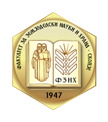PRACTICAL APPLICATION OF QSAR TECHNIQUE FOR PREDICTION OF BIOLOGICAL ACTIVITY OF SELECTED HYDRAZONES
Keywords:
biological activity, p-substituted hydrazones, QSAR, statistical evaluationAbstract
One important class of organic compounds is hydrazones which find huge application in many scientific areas. They demonstrate fascinating biological activities like as antioxidant, anti-inflammatory, anticonvulsants, antidepressant, anxiolytic, antihypertensive, anticancer, antimicrobial, anti-tuberculosis, and antifungal activity. This wide palette of the useful medical properties has attracted considerable scientific interest for their synthesis. The biological activity and the changes in this activity depend on the substituents present in the hydrazone molecule. The hydrazones can be used in agriculture as herbicides, insecticides, and plant growth stimulants because of their physiological properties. A series of substituted aromatic hydrazones have been synthesized and evaluated for in vitro antimicrobial activity against: Bacillus subtilis. QSAR study was performed to estimate the quantitative effects of the selected descriptors of derivatives on their antibacterial activity. Topological and physicochemical descriptors were calculated for each molecule and a several two-parametric mathematical models have been selected for further discussion. The statistical significance of each model was measured by a few cross-validation parameters (Q, PRESS/SSY; SPRESS; PSE andQ2). Statistical evaluation of the data used to test the quality of the obtained models, indicated that in statistically significant model both parameters AC (Atom count) and MAPA (Maximal projection area) have opposite input to the modeling of biological activity of the selected hydrazones. Following statistical parameters were obtained for this model: R2 = 0.9444; Sd = 0.0097; F-test = 101.9875; R2adj = 0.9352; Q = 100.1858; PRESS/SSY = 0.0564; SPRESS = 0.0098; PSE = 0.0088 and Q2 = 0.9436.
References
Ahmed, M., Jackstell, R., Seayad, A. M., Klein, H., Beller, M. (2004). Highly selective synthesis of hydrazones and indoles from olefins. Tetrahedron Letters, 45: 869-873.
Bansal, R., Karthikeyan, C., Moorthy, H. N., Trivedi, P. (2007). QSAR analysis of some phthalimide analogues based inhibitors of HIV-1 integrase. The Archive for Organic Chemistry (ARKIVOC), XV: 66-81.
Basak, S. C., Guteand, B. D., Grunwald, G. D. (1999). A hierarchical approach to the development of QSAR models using topological, geometrical and quantum chemical parameters, Topological Indices and Related Descriptors in QSAR and QSPR, J. Devillers, A. T. Balaban (Eds.), Gordon and Breach Science Publishers, 692.
Chohan, Z. H., Sherazi, S. K. A. (1997). Biological Role of Cobalt(II), Copper(II) and Nickel(II) Metal Ions on the Antibacterial Properties of Some NicotinoylHydrazine Derived Compounds. Metal-Based drugs, 4: 69-74.
Jankulovska, M., Čolančeska-Rağenoviќ, K., Dimova, V., Spirevska, I. (2012). Synthesis and characterization of new p-substituted aromatic hydrazones. Organic Chemistry: An Indian Journal, 8: 326-334.
Juneja, S. K., Gupta, M., Paul, S., Gupta, R. (2008). Solvent-free Procedure for the Regeneration of Carbonyl Compounds from Nitrogeneous Derivatives Using Dioxane-dibromide/SiO2. Bulletin Korean Chemical Society, 29: 2337-2340.
Kaymakçıoğlu, B. K., Emre, E. E., O. Unsalan, S., Rollas, S. (2009). Antituberculosis activity of hydrazones derived from 4-fluorobenzoic acid hydrazide. Medicinal Chemistry Research, 18: 277-286.
Leite, A. C. L. Moreira, D. R. M., Coelho, L. C. D., Menezes, F. D. (2008). Synthesis of aryl-hydrazones via ultrasound irradiation in aqueous medium. Tetrahedron Letters, 49: 1538-1541.
Liu, M., Wang, Y., Wangyang, W., Liu, F., Cui, Y., Duan, Y., Wang, M., Liu, S., Rui, C. (2010). Design, Design, synthesis, and insecticidal activities of phthalamides containing a hydrazone substructure. Journal of Agriculture and Food Chemistry, 58: 6858-6863.
Marvin Sketch 6.2.1, www.chemaxon.com Rollas, S., Küзükgüzel, Ş. G. (2007). Biological Activities of Hydrazone Derivatives. Molecules, 12: 1910-1939.
Salgın-Gökşen, U., Gökhan-Kelekçi, N., Göktaş, Ö., Köysal, Y., Kılıç, E., Işık, Ş., Aktay, G., Özalp, M. (2007). 1-Acylthiosemicarbazides, 1,2,4-triazole-5(4H)thiones, 1,3,4-thiadiazoles and hydrazones containing 5-methyl-2benzoxazolinones: Synthesis, analgesic-anti-inflammatory and antimicrobial activities. Bioorganic Medicinal Chemistry, 15: 5738-5751.
Sears, J. K., Darby, J. R. The Technology of Plasticizers, John Wiley & Sons, New York, 2003.
Singh, J., Shaik, B., Singh, S., Agrawal1, V. K., Khadikar, P. V., Deeb, O., Supuran, C. T. (2008). Comparative QSAR study on para-substituted aromatic sulphonamides as CAII inhibitors: information versus topological (distance-based and connectivity) indices. Chemical Biology & Drug Design, 71: 244-259.
Sridhar, P., Alagumuthu, M. S., Arumugam, S., Reddy, R. (2016). Synthesis of quinoline acetohydrazide-hydrazone derivatives evaluated as DNA gyrase inhibitors and potent antimicrobial agents. RSC Advances, 69: 64460-64468.
STATISTICA program package, http://www.statsoft.com
Suarez-Iha, M. E., Pehkonen, S. O., Hoffman, M. R. (1994). Stability, Stoichiometry, and Structure of Fe(II) and Fe(III) Complexes with Di-2-pyridyl Ketone Benzoylhydrazone: Environmental Applications. Environmental Science & Technology, 28: 2080-2086.
Terra, L. H. S. A., Areias, M. C. C., Gaubeur, I., Suez-Iha, M. E. V. (1999). Solvent Extraction-Spectrophotometric Determination of Nickel(II) in Natural Waters Using DI-2-Pyridyl Ketone Benzoylhydrazone. Spectroscopy Letters, 32: 257-271.
Thakur, A. (2005). QSAR study on benzenesulfonamide dissociation constant pKa: physicochemical approach using surface tension. The Archive for Organic Chemistry (ARKIVOC), XIV: 49-58.
Veerasamy, R., Rajak, H., Jain, A., Sivadasan, S., Varghese, C. P., Agrawal, R. K. (2011). Validation of QSAR models - Strategies and importance. International Journal of Drug Design & Discovery (IJDDD), 2: 511-519.



